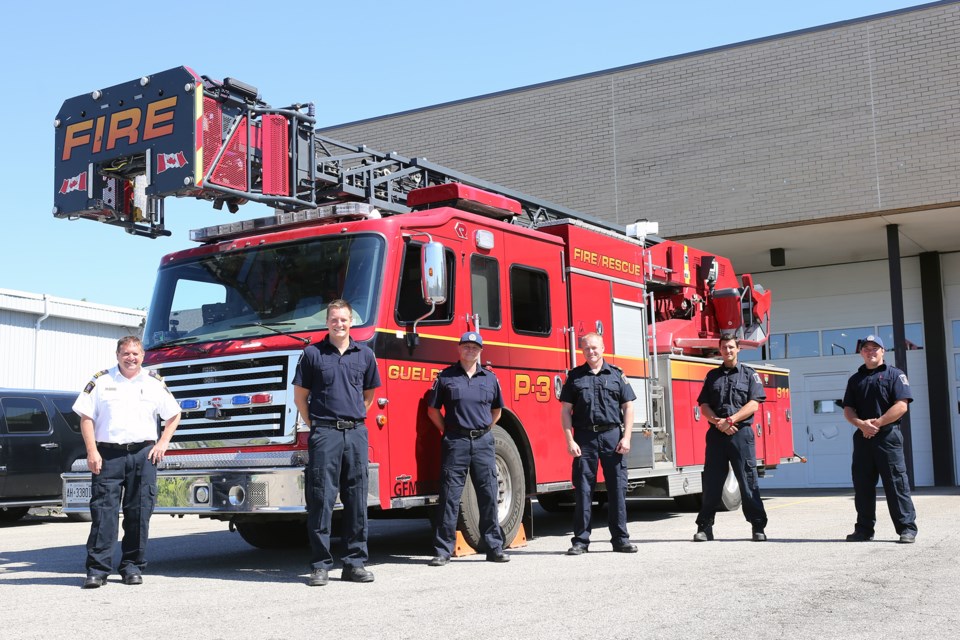Firefighters in Guelph have a unique working arrangement that may help in reducing exposure to COVID-19 while working on the front lines, says one of the platoon chiefs of the Guelph Fire Department.
In a recent interview, platoon chief Andy Sanvido told GuelphToday that some firefighters initially felt anxiety at the start of the COVID-19 pandemic
“Everyone was concerned about contracting it and bringing it home to their families,” said Sanvido.
At the beginning of the pandemic the fire department’s management put together working groups collectively put in charge of all aspects of response to the pandemic, from ensuring there was enough personal protective equipment (PPE) to ensuring every firefighter was trained in its proper use and disposal.
“We would all sit down and make game plans and agree to changes and things that were going to help us with the delivery of our service while maintaining the safety for us and the public,” said Sanvido.
After each use on scene, the driver of each fire truck is responsible for collecting and disposing of PPE by their fellow firefighters.
“Everyone doffs their contaminated PPE very carefully into this container and the container gets wrapped up, put in a cabinet outside the vehicle so it doesn’t go into the cab and it gets discarded when we return (to the station),” said Sanvido.
Coming up with protocols with firefighter safety in mind helped to alleviate a lot of the initial anxiety.
“When you come up with step-by-step processes and let the firefighters know we have the equipment and how to use it properly you will be okay. That’s your best defence through all of this,” said Sanvido.
Firefighters in Guelph work 24 hour shifts, an arrangement that Sanvido said has its benefits during the COVID-19 pandemic.
“When you have multiple shifts coming in during the day — say three eight hour shifts — in my opinion you would have more people coming in every single six stations, so you have more of a chance of cross-contamination than you do when you have one platoon fully for 24 hours,” he said.
“There are probably advantages and disadvantages to (24 hour shifts). As far as COVID goes, I can’t really say that would be a negative,” said Sanvido.
At the beginning of every shift, firefighters must take their temperature and complete a self-assessment prior to entering the fire station.
“We are counting on people to say if they are not well they shouldn’t be here,” said Sanvido “It’s like a family when you come in here. It’s definitely affected them but they are getting used to it.”
After entering, firefighters are instructed to physically distance as best they can during their 24 hour shifts, but it becomes more difficult when training together and impossible once they enter a firetruck on their way to a call.
“Firefighters are very quickly adaptable, so they have adapted well to it and do what they have to do — thats just the way they are,” said Sanvido.
When attending medical calls, use of PPE becomes even more important. Firefighters assign different levels of PPE use to different situations.
“When we go for something like difficulty breathing or chest pain or blunt trauma, what we would normally do is send one firefighter to the door,” said Sanvido. “They will make contact with the patient from approximately three metres away. Once they do a verbal assessment from a distance, they decide whether a second firefighter should enter and whether the PPE level needs to be increased.”
The level of PPE use is constantly being reassessed during a call.
“If it’s a confirmed vital signs absent, two firefighters in full PPE — which is tyvek suit, N95 mask, face shield — they go in and perform CPR with what we call a Level 2 response.”
“We want to expose the least amount of people as possible, without affecting the care we are giving to the patients,” said Sanvido.
Public eduction efforts have also been affected by COVID-19.
“All of the city buildings are now closed as part of the emergency pandemic plan, so that cuts out any station tours we used to do for groups like Boy Scouts or Girl Guides,” said Sanvido. School is not in session, but we would do field trips and things like that where we give them a tour of the station. Our fire prevention division would go out and do public education in places, that was put to a halt.”
The Hot Summer Nights event put on by the fire department usually happens in late June but is also cancelled this year.
“It’s a scheduled even either at a school or a public park where we would go out — paramedics and police would also attend if they could — and we would let the public see our trucks, go inside and another group would hook up to a hydrant and spray water on the kids if it was warm,” said Sanvido. “Unfortunately the public is missing out on our public relations events.”



